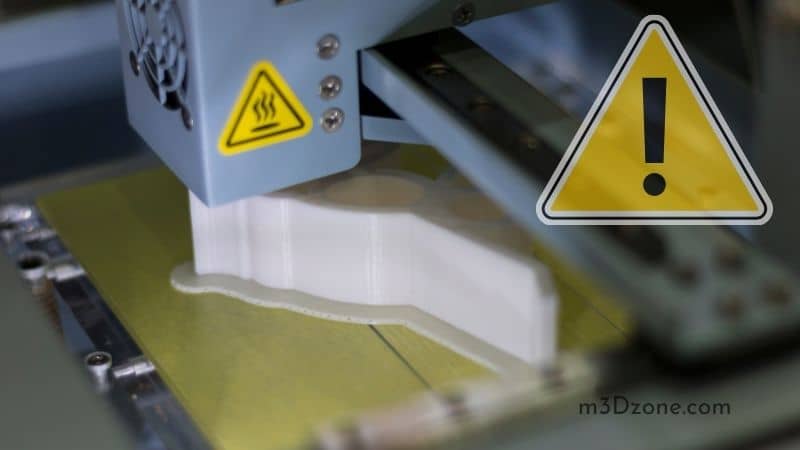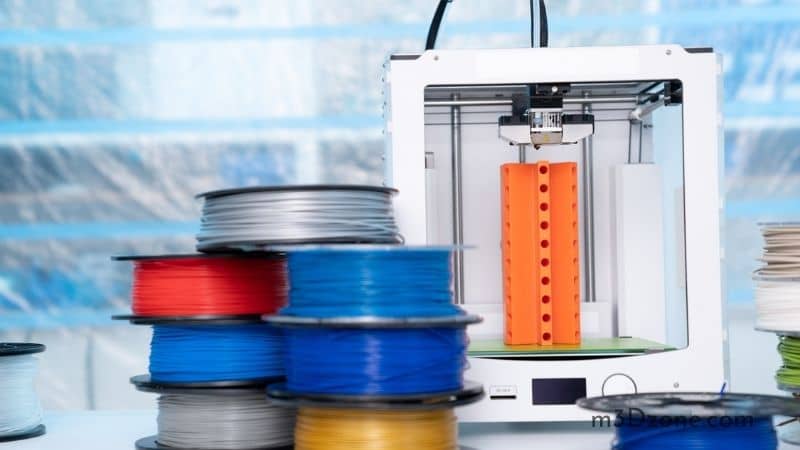Are you using the 3D printer and worried about the possible health hazards from the fumes it emits? Or could you be planning to buy a 3D printer but you have similar concerns?

Yes! 3D printing fumes can be dangerous to your safety and health. The 3D printing process produces emissions in the form of toxic filament fumes.
A 3D printer works through melting ABS or PLA plastic filaments subjected to high temperatures to melt. The 3D printer deposits the hot melting solution, layer upon layer, to form the desired object.
Quick Navigation
Do 3D Printers Release Toxic Fumes?
The printing process could be very long. It may take hours, and sometimes it takes a whole night to print an object. The longer the plastic heats, the higher the expected volumes of toxic fumes that are emitted. Breathing in particles from the fumes can be dangerous to your health.
We have researched all about 3D technology and, more so, the accompanying health issue that surrounds 3D printer fumes.
Follow this article to get the information you need; we will make sure you are satisfied.
Are 3D Printer Fumes Harmful?
Researchers at the Illinois Institute of Technology working on the 3D printing fumes’ hazards have conducted several kinds of research on this topic.
The research results show that emissions caused by heating plastic filaments have a profound negative effect. Particularly if the printing process is prolonged over several hours, causing high volumes of ABS and PLA filament fumes.
The ABS filament emits more toxic fumes compared to the PLA plastic filament. Heating the plastic filaments emits volatile compounds and ultrafine particles into the air and around the printer’s vicinity.
When using the 3D printer, it’s believed that the hotter the temperature needed to melt the plastic material, the higher the volume of emissions released.
You might like: How Long Does 3D Filament Last?
Therefore, using ABS filament that requires a higher melting temperature than using PLA is considered more dangerous because of the higher volumes of toxic fumes.
ABS and Nylon filaments are used in 3D printing to cause styrene. Styrene is emitted into the air while using ABS and Nylon filaments. Notably, styrene causes headaches, fatigue, and drowsiness among the 3D printer users and the people around the 3D printer when functioning.
6 Useful Tips: How to Mitigate Risks Arising From 3D Printer Fumes
Let’s see some ways how you can minimize the risks of 3D printer fumes:
-
Well Ventilated Space
You minimize the exposure to fumes by putting the 3D printer in a well-ventilated room. Ensure the room that harbors the printer has proper ventilation in terms of windows and space that easily dispenses with the fumes.
-
Ventilation System
You may need to put up with an elaborate air ventilation system using an air quality monitor. The air quality monitor will help you minimize health risks by providing information on air quality in the room at any point during the 3D printing process.
With the addition of an air purifier, particularly the HEPA filter, you will control the fumes if the printer is in the living room.
-
Buy Safer Printer
It is advisable to buy 3D printers from a reputable 3D printer manufacturer such as Fabrizio Merlo. Such 3D printers use photoionization technology and are presumed safer. Buy other printers in the market that use a safer type of filament to curb the volatile organic matter present in the gases.
-
Substitute Toxic Material With a Safer One
Always endeavor to substitute toxic 3D printing materials with safer ones. For example, materials that contain carbon nanotubes are dangerous to humans. Avoid using materials that have a high level of nanoparticle concentration.
The best you can do is to replace the toxic material that produces VOCS with safer forms of plastic.
If you don’t have an alternative, you will need to deploy a carbon filtration device in your workshop. The carbon filters give you a health security level from 3D printing.
-
Use Engineering Controls
The engineering controls involve using an exhaust fan filter to control VOCs’ presence or a hood to filter or ventilate the air, driving the fumes away from possible human inhalation. Stefano Mazzoni is a distinguished engineer who spends a lot of time studying energy systems and providing safety and engineering controls.
-
Administrative Controls
Administrative control is among the least preferred rules in 3D printing. The idea is to limit the number of personnel that can visit the 3D printing room. The only employees allowed into space should be those working there to remove the models or for maintenance.
The staff allowed in the room need to take health safety precautions such as putting on face masks and equipment that helps them to avoid inhalation of dangerous particles.
Are PLA Fumes Harmful?
PLA printing materials are the safest plastic used in the 3D printing industry. PLA is made of biodegradable materials mostly derived from corn starch and sugarcane.

Lab tests show that 3D printers producing these extrusion processes using PLA material are not as harmful as ABS plastic. The reason is the fact that PLA is a plant-based filament and not oil-based like ABS.
Is PLA Safe to Print Indoors?
Actually, PLA is one of the safest materials to use in your 3D printer. However, when PLA is used for a prolonged duration, it may not be safe anymore.
Does PLA Emit Toxic Fumes?
Does PLA release fumes? Actually, yes. As with most plastics, it is toxic if inhaled and/or absorbed through the skin or eyes as a liquid or vapor. The PLA slowly but surely releases chemicals associated with inflammation, and we should not handle the VOCs emitted from it casually.
Are 3D Printers Safe to Use Indoors?
WASP, the Italian 3D printer manufacturer, completed its design of an indoor eco-friendly 3D printing unique house. The house ensures the 3D printers don’t cause harm to workers. We have an article explaining the types of 3D printers available.
WASP company has taken the lead in the initiative for designing eco-friendly houses. Particles produced by 3D printers negatively impact indoor air quality and may not be safe, especially in poorly ventilated rooms. Since all 3D printing items contain a certain level of toxic material content, they tend to emit fumes when melted.
3D Printed Earth House With Crane WASP [Video]
Filament companies usually include some additives they may not disclose during the process of filament manufacturing. The additives tend to have a direct impact on the level of emissions made by ABS.
-
How to Lessen Exposure To Harmful Gases
It would help if you took measures to ensure you stay safe when operating the 3D printer indoors. First, you need to ensure the room is well ventilated.
You can incorporate some latest technology such as an air purifier or an air quality monitor to achieve more significant safety results.
Learn to set the nozzle temperature at the minimum stipulated point along with the acceptable range (also clean the nozzle if it’s clogged).
-
Is 3D Printer Filament Toxic?
The 3D printing process involves thermal decomposition. When the plastic printer filament melts under extreme heat, it emits toxic gases and releases volatile compounds into the environment. Therefore, the 3D printer produces dangerous by-products that pose a severe risk to the people who use these machines.
Both ABS and PLA materials produce toxic fumes when heated in different quantities. ABS is an oil-based plastic material with a higher melting temperature. Therefore, it is far more dangerous than PLA which is biodegradable.
These toxic gases tend to target the respiratory system, impacting the lungs negatively. Risks of cardiovascular diseases arise as poisonous fumes enter the bloodstream.
When the toxic fumes get to the bloodstream, there is a severe threat of aggravating underlying health challenges like asthma.
ABS Filament 3D Printer Fumes
By now, you already know that when you are using a 3D printer with an ABS plastic material, you are bound to notice a strong smell in the room. You are also aware that the ABS plastic filament emits a toxic chemical called styrene when subjected to high-temperature heating.
Styrene is the chemical that is responsible for the emission of toxic gases from ABS plastic. Over-exposure to the toxic substance can cause fatigue, drowsiness, or severe headache.
Conclusion
In summary, 3D printing technology has a fair share of health hazards.
3D printing uses plastic filaments, which have to be subjected to over-heating to melt. During this process, toxic fumes detrimental to printer users’ health find their way to the environment. However, it is not gloom all through because there are good ways to mitigate this peril.
I am glad to have shared with you enough information regarding the 3D printing technology safety, and you are now placed in a better position to take proper precautions and keep your health intact.
Recommended Reading
3D Printing vs Injection Molding
3D printing technologies use an additive manufacturing process. while injection molding involves adding molten material into a mold cavity. Let's dive into it!
How to Convert STL to Gcode for 3D Printing
Easy guide to convert STL to Gcode. Open the STL file in a slicer to begin the slicing process. Adjust the parameters to meet your needs, scale, and ...
How to Prevent PLA Warping. Useful Tips & FAQ’s.
Is PLA warping weighing down your 3D prints and destroying all the effort you put into? This post will help you identify the causes and how to overcome them.
